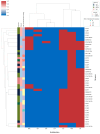Antimicrobial Activity of a Synthetic Brevibacillin Analog Against Multidrug-Resistant Campylobacter spp
- PMID: 40429801
- PMCID: PMC12111383
- DOI: 10.3390/ijms26104657
Antimicrobial Activity of a Synthetic Brevibacillin Analog Against Multidrug-Resistant Campylobacter spp
Abstract
Campylobacter spp. is one of the most prevalent causes of zoonotic foodborne infections associated with diarrhea in humans. The growing threat of antibiotic resistance calls for innovative approaches. The antimicrobial lipopeptide brevibacillin produced by Brevibacillus laterosporus and its synthetic analog brevibacillin Thr1 showed promising activity against Salmonella and E. coli. The latter is a 1602.13 Da positively charged (+3) synthetic peptide of 13 residues that showed reduced cytotoxicity (IC50 of 32.2 µg/mL against Caco-2 cells) and hemolytic activity (1.2% hemolysis at 128 µg/mL) compared to the native peptide. It contains an N-terminal L-isoleucic fatty acid chain and four non-proteinogenic amino acids and ends with valinol at its C-terminus. One key structural modification is the substitution of α,β-dehydrobutyric acid with threonine. We investigated the antimicrobial potential of the synthetic brevibacillin Thr1 analog against a collection of 44 clinical Campylobacter spp. that were obtained from two reference laboratories. Susceptibility testing revealed marked resistance to ciprofloxacin, tetracycline, and ampicillin among the strains, with more than half expressing a multidrug-resistant phenotype. The genomes of the 44 strains were sequenced to study the genes responsible for their antimicrobial resistance. Tetracycline resistance was associated with tet(O), ciprofloxacin resistance with mutations in gyrA and regulatory sequences modulating the expression of an efflux system, and aminoglycoside resistance with genes of the aph family. The brevibacillin Thr1 analog was produced by chemical synthesis, and evaluation of its activity against a subset of clinical strains by microdilution revealed minimum inhibitory concentration and minimum bactericidal concentration ranging from 8 µg/mL to 64 µg/mL. The peptide was active against multidrug-resistant isolates with a bactericidal effect. Of note, despite numerous attempts, it proved impossible to select Campylobacter spp. for resistance to the brevibacillin Thr1 analog. These results underline the potential of lipopeptides, notably brevibacillin, as antimicrobial alternatives against antibiotic-resistant Campylobacter bacterial infections.
Keywords: Campylobacter spp.; WGS; antibiotics; brevibacillin; multidrug resistance.
Conflict of interest statement
The authors have no competing interests to declare.
Figures



Similar articles
-
Discovery of a Novel Antimicrobial Lipopeptide, Brevibacillin V, from Brevibacillus laterosporus fmb70 and Its Application on the Preservation of Skim Milk.J Agric Food Chem. 2019 Nov 13;67(45):12452-12460. doi: 10.1021/acs.jafc.9b04113. Epub 2019 Nov 1. J Agric Food Chem. 2019. PMID: 31674183
-
Isolation and Structural Elucidation of Brevibacillin, an Antimicrobial Lipopeptide from Brevibacillus laterosporus That Combats Drug-Resistant Gram-Positive Bacteria.Appl Environ Microbiol. 2016 Apr 18;82(9):2763-2772. doi: 10.1128/AEM.00315-16. Print 2016 May. Appl Environ Microbiol. 2016. PMID: 26921428 Free PMC article.
-
The determination of antibacterial mode for cationic lipopeptides brevibacillins against Salmonella typhimurium by quantum chemistry calculation.Appl Microbiol Biotechnol. 2021 Jul;105(13):5643-5655. doi: 10.1007/s00253-021-11398-5. Epub 2021 Jun 23. Appl Microbiol Biotechnol. 2021. PMID: 34160646
-
Brevibacillin 2V, a Novel Antimicrobial Lipopeptide With an Exceptionally Low Hemolytic Activity.Front Microbiol. 2021 Jun 17;12:693725. doi: 10.3389/fmicb.2021.693725. eCollection 2021. Front Microbiol. 2021. PMID: 34220785 Free PMC article.
-
Campylobacter and fluoroquinolones: a bias data set?Environ Microbiol. 2003 Apr;5(4):219-30. doi: 10.1046/j.1462-2920.2003.00425.x. Environ Microbiol. 2003. PMID: 12662169 Review.
References
-
- WHO Antimicrobial Resistance: WHO. 2023. [(accessed on 17 November 2021)]. Available online: https://www.who.int/health-topics/antimicrobial-resistance.
-
- Tong S., Ma L., Ronholm J., Hsiao W., Lu X. Whole genome sequencing of Campylobacter in agri-food surveillance. Curr. Opin. Food Sci. 2021;39:130–139. doi: 10.1016/j.cofs.2020.12.020. - DOI
MeSH terms
Substances
Grants and funding
LinkOut - more resources
Full Text Sources
Medical
Miscellaneous

